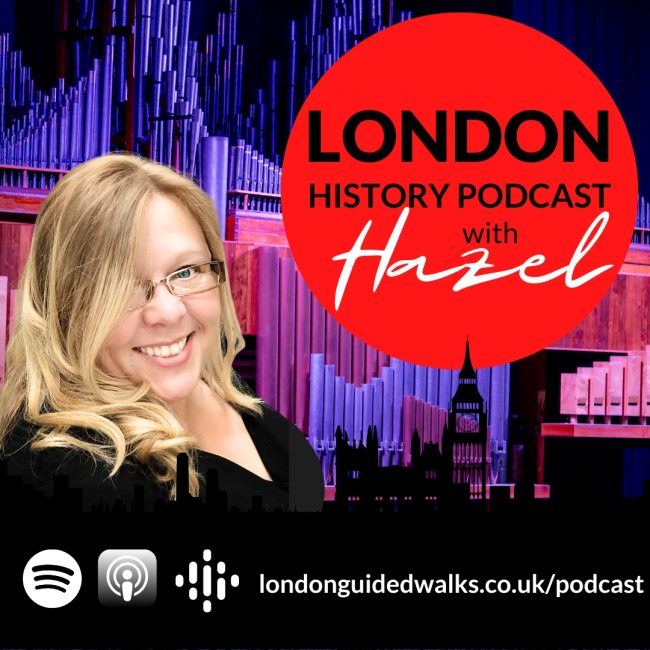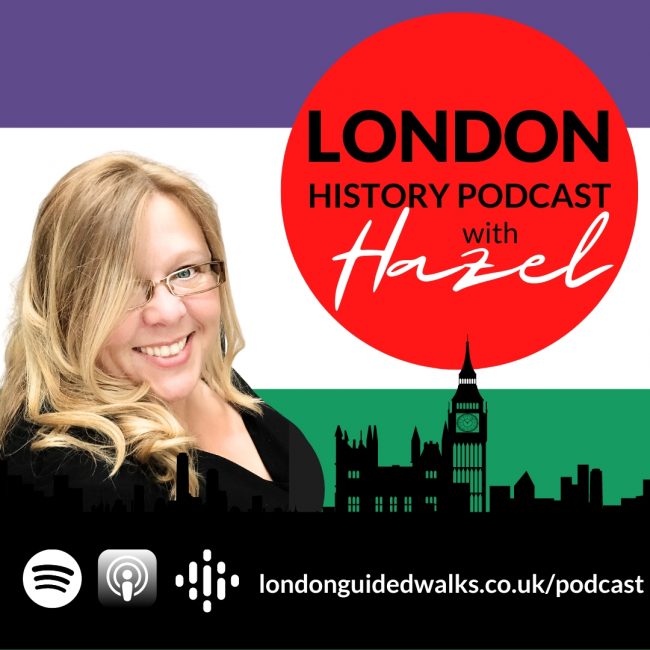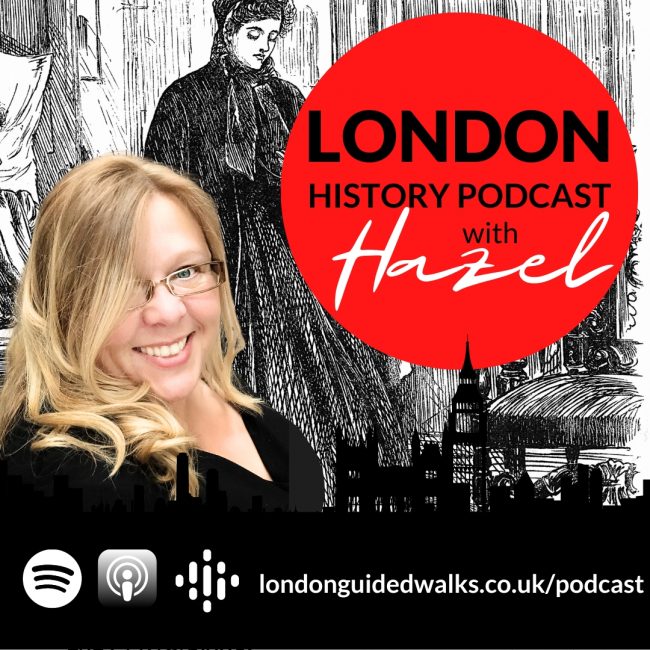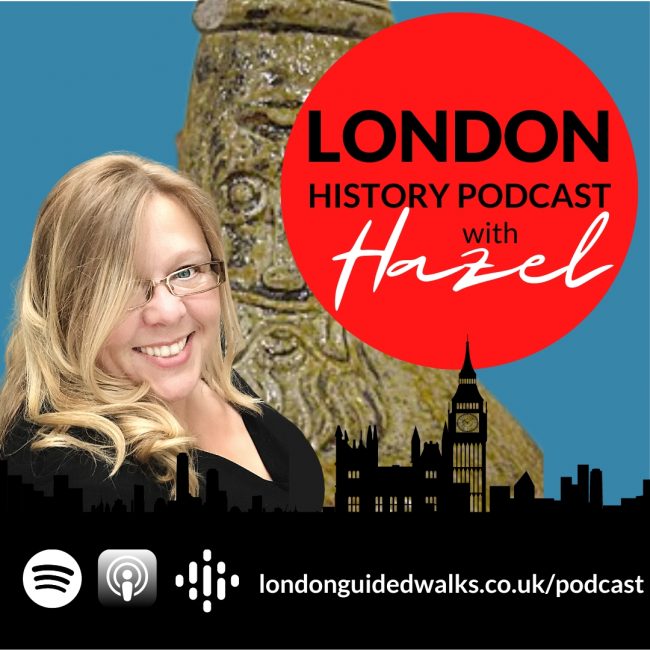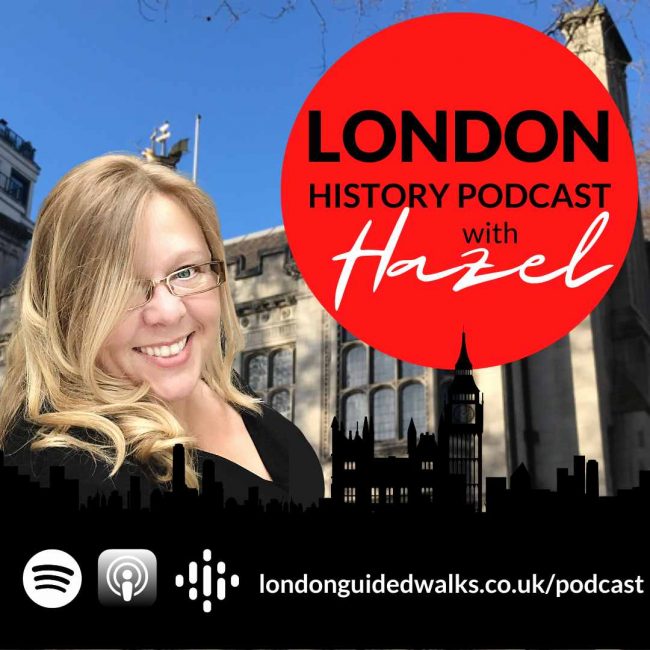Useful links:
Episode 114: Buckingham Palace
Episode 48: Leper Houses in London
Episode 126: Transatlantic Slave Trade and London
Episode 42: John Julius Abgerstein
Royal London Walking Tour
Quirky London Walking Tour
Transcript
Hazel Baker: We are back for another fact-filled episode. Today, our journey takes us to the very heart of the city, where history comes alive in the magnificent St. James’s Palace.
Nestled in the heart of London, St. James’s Palace is a place of profound historical significance, where centuries of tradition, grandeur, and intrigue have woven a rich tapestry. As we venture within its hallowed halls and uncover its hidden secrets, we will unravel the captivating history that has unfolded within these venerable walls.
Joining me in the studio today is Philip Scott. He is a City of Westminster tour guide and he does a lot of our Whitehall and Royal London tours. So of course, he’s the perfect person to add to our Royal Palaces podcast series because of course he did Episode 114 Buckingham Palace one. So now we’re going to move to St James’s Palace, which is quite a special place.
Hello, Phil.
Philip Scott: Hello, nice to be here again.
Hazel Baker: Now this is a good one because I have you to thank for giving me the heads up of stalls round St. James’s Palace at the end of 2023. And I thought it was really quite magical. What about yourself?
Yeah, I really enjoyed going round. It was a very pleasant surprise and it was an opportunity that I didn’t actually think I’d ever get.
Philip Scott: No, I totally agree. And also, even though I’ve seen it so many times and read so much about the history, actually walking through the physical building adds that other dimension, which I’m super happy to have done that. So yeah, thank you very much for the heads up on that one.
Hazel Baker: So it’s worth starting, I think, at the very beginning and to ask you really why the Palace of St.James is so called.
Philip Scott: It was actually built on the site of an old leper hospital, dedicated to St. James the Less, who was the patron saint of the dying. And at one time, 14 leprous women were housed in the hospital. The hospital was in a very isolated place. It was an awful lot of stigma attached to leprosy.
Lepers were very much social outcasts. So the hospital was not in the built up area that the palace is in today. The hospital at one time actually housed 14 leprous women. By the time St. James’s Palace came to be built, there were just four of them left. And the hospital was originally built in the late 10th century.
Hazel Baker: Wow. If anybody wants to hear a little bit more about leper houses in London, then you can have a little listen to Episode 48 Leper Houses in London, where I talk with our esteemed colleague, Ian McDiarmid, our guide with City of London. And he discusses what is leprosy, how it was identified, how many leper houses were in mediaeval London in total.
And also, if you want to know how zombies feature in that episode, have a listen to So going on to who built the palace then, if it’s only four leprous women left, a new palace is built, why, and by whom?
It was actually built by Henry VIII between 1531 and 1537. Henry VIII possibly wanted his second wife Anne Boleyn to live there, but he had her executed at the Tower of London before she could actually move in.
Henry VIII said that she had engaged in adultery. Witchcraft, incest, and treason. There’s almost no evidence to actually back up any of those. There is actually a fireplace inside the palace with the initials of Henry VIII. An ambulance underneath the mantelpiece, which actually gives weight to the theory that it was meant for her to live in.
Some have suggested, however, that it was intended for his illegitimate son, Henry Fitzroy, who lived there for a while before dying from tuberculosis.
I was amazed to see that the fireplace, because of course you get to see a few of the missed HAs in Hampton Court. Yes. But I didn’t know about the fireplace one, so I was absolutely delighted with that one.
For me as well, that was a real highlight.
Hazel Baker: The Palace of St. James was built in brick, not stone. So why was that?
Philip Scott: Quite simply, it was an expensive building commodity, which only the rich could afford. Red brick was used to impress people.
Hazel Baker: And it does look very impressive, doesn’t it?
Philip Scott: It does, yeah.
Hazel Baker: Especially with the white mortar, it looks quite psychedelic really, especially when the sun’s hitting on it. And when did it become a royal, the official royal palace that we know now in the residence of the Monarch?
Philip Scott: It became the official Royal Residence and Palace. When the Palace of Whitehall burnt down on the 4th of January, 1698.
It burnt down. It’s in its entirety apart from the banqueting house, which is still there. Henry VI eights wine cellar, and the Queen Mary steps. After the Palace of Whitehall had burnt down, King William III made it the official royal palace. He actually moved in with his sister in law, Princess Anne, who was the future Queen Anne.
In reality, William III spent little time there. He preferred Kensington Palace, Hampton Court, and Windsor. It remained the official residence of the monarch until 1837 when Queen Victoria moved into Buckingham Palace. and
started her own new trend. So St. James’s Palace is famous for a particular kind of event which has only happened once in most people’s lifetime.
Hazel Baker: So can you tell us a little bit more about that?
Philip Scott: Sure. Monarchs are proclaimed monarch on the balcony. Charles III was proclaimed king on the 10th of September 2022, the moment that his mother the late Queen Elizabeth II died, he became the king, but he wasn’t officially proclaimed king, declared king until two days later.
Now prior to the proclamation, there had been a meeting of the accession council in the palace and for the first time ever in 2022, it was televised. Interestingly, Edward VIII, when he was proclaimed king from the balcony, he was actually watching it from a window, and he had with him a mystery woman.
At the time, nobody realised who she was, but as 1936 progressed, it became obvious that it was his lover, Mrs. Wallis Simpson, and by December of that year, he was gone. And the rest is history.
Hazel Baker: Yeah, indeed. I remember standing in that room when doing the St. James’s tour, and of course we know that they don’t walk through a door, they walk through a window, but it was nice to actually see the window from the other side.
Philip Scott: Yes, absolutely.
Hazel Baker: So have there been any significant births at that palace?
Philip Scott: Actually, there have been quite a number over the years. Quite a lot of monarchs were born in the palace. For example, King Charles II, King James I, Queen Mary II and Queen Anne were all born there. Also, George IV was born in St James’s Palace.
James II and Mary of Modena. They had a child who was born in the palace, James Francis Edward Stuart, and he became nicknamed the Bedpan Baby.
Now you’re going to have to explain that to some of our listeners.
It goes like this: James II, his first wife, died, and he remarried Mary of Modena. She was a devout Roman Catholic, and in fact, James II also became a Roman Catholic, and this was at a time when there was a very strong anti Roman Catholic attitude in England.
In 1673, a series of laws called the Test Acts actually banned Roman Catholics from civil or military office. James II, in defiance of these acts, had actually appointed various Roman Catholics to various positions of state. The survival of the baby was greeted with consternation, especially as the Pope was one of the godparents.
Now, rumours started circulating that the baby had died because Mary had numerous miscarriages, and that another baby had been smuggled into the palace in a bed warming pan. Now, Princess Anne and Princess Mary, the daughters of James II, they gave some credence to these rumours. Both of them were actually in line to the throne.
Mary, the eldest daughter, was childless, so it was fairly clear that at some point her younger sister, Anne, would follow her. Not long after this, James II was actually forced to abdicate in favour of his Protestant daughter, Mary. She was married to her cousin, William of Orange, the stadtholder of the Dutch Republic, the nephew of James II.
And they were actually proclaimed joint monarchs for the first time ever. We had two monarchs of equal status, and they were declared joint monarchs at St. James’s Palace. James II sent his queen consort and the baby to France, and he followed shortly afterwards. After the proclamation of William and Mary as joint monarchs, they followed something called the Glorious Revolution, which reduced the power of the monarch and also ensured the supremacy of the Protestant succession, and in fact, this ensuring of the supremacy of the Protestant succession, it culminated in the Act of Settlement 1701, which is still in force, which meant that no Roman Catholic could ever become monarch.
This meant that James II’s son would never become the king. Now, he actually became known as the Old Pretender as he tried and failed to gain the throne in 1714, after Queen Anne died and George I became king. His son, Charles, became known as the Young Pretender, also known as Bonnie Prince Charlie, and in 1745 he tried and failed to gain the throne.
Now, James II actually tried to reclaim his throne. He arrived in Ireland and he was trying to raise an army there to invade England, but William of Orange actually went over to Ireland and King James II was defeated at the Battle of the Boyne.
Hazel Baker: Oh, it sounds all very exciting, doesn’t it, Stuart, history? And of course, a lot of people familiar with the story of Outlander are going to be knitting all of this together now. Brilliant. Okay, so we’ve done Significant Births and of course a wonderful Bedpan Scandal, which was a perfect example of fake news for the time.
Absolutely, we think it’s something new, don’t we?
We do. But actually, it’s been going on for years.
Yeah, oh totally. Can you maybe talk a little bit about the really quite important link between Ambassadors to the UK and St James’s Palace?
Philip Scott: Yeah, sure. All ambassadors and high commissioners are officially known not as the ambassador or the high commissioner to the United Kingdom, but the ambassador or high commissioner to the court of St.
James’s, even though It’s 1837 since St. James’s Palace was the official royal palace. High commissioners, by the way, are the name that is given to ambassadors from Commonwealth countries. With regards embassies that are close to St. James’s Palace, there aren’t very many. However, there is one embassy across the road, and that is the Embassy of Sudan.
Sadly, Sudan is a country that is at the moment suffering from a tragic civil war. This next example is a piece of interesting trivia, but from 1842 to 1845 there was a short lived legation from the Republic of Texas to the court of St. James’s above Berry Brothers and Rudd. The wine merchants on St.
James’s Street, very close to the palace. Legation closed down in 1845, when the Republic of Texas became a state of the United States. And in fact, they left a debt of 160, which wasn’t finally paid. Until 1986, when some businessmen turned up at Berry Brothers and Rudd to settle the debt. The Republic of Texas, it only lasted for around nine years.
It broke away from Mexico.
Hazel Baker: I think people need to go on your Quirky Westminster walk, Phil.
Philip Scott: I think they very probably do.
And what about any key or significant international events that have happened there? What have we got?
Yeah, quite a lot of things have happened at St James’s Palace that would constitute an international event of significance.
In some ways it’s quite hard to ascertain which are the most significant, but here are just a few examples. Mary Queen Mary I, she signed Calais away at St. James’s Palace in 1558. Calais was the last English possession in France. She also died in St. James’s Palace in the same year. Elizabeth I was actually at St.
James’s Palace when she heard about the Spanish Armada and she set off from St. James’s Palace to Tilbury in Essex where she made her famous address to
Hazel Baker: And though I may be a weak and feeble woman, I have the heart and stomach of a king, and a king of England, too!
Philip Scott: Absolutely. Wow. I’m impressed. Jumping ahead to the 20th century, the Treaty of London was signed in St.
James’s Palace, which resulted in Albanian independence from the Ottoman Empire. In 1931, there was a very major conference held at St. James’s Palace, the Westminster Conference, and the main topic of discussion was the extent to which British India should be given greater autonomy. And he was there. From the Indian side, he was actually given an office in St.
James’s Palace for the duration of the conference. Now, from an Indian perspective, the conference did not result in success. The desires of the Indian delegation for greater self government were not met by the British. And in fact, Indian independence didn’t come about until after the Second World War.
Another important conference that was held at St. James’s Palace is a conference that very much resonates with the main news story of the day. We’re making this podcast at the beginning of 2024, and the Israel Palestine conflict is very much in the news. In 1939, It was an international peace conference at St.
James’s Palace, all about the British mandated territory of Palestine. The Jewish and Arab delegations, they refused to sit in the same room, discussions were held separately, and resulted in a complete impasse about the future of Palestine. It was a very serious conference. But a bit of light relief came when at one point the emir of Yemen, a country again very much in the news at the beginning of 2024, the emir of Yemen and emir Faisal of Saudi Arabia, they climbed through the armoury window overlooking Friary Court so that they could watch the changing of the guard ceremony. Another significant conference was held in 1941. It was called the Inter Allied Conference. In summary, eight governments in exile. Plus the United Kingdom and four of its five dominions. The dominions were independent countries within the British empire.
And the four countries were Australia, Canada, New Zealand, and South Africa. These countries together were actually created. at the first of six treaties, which led to the establishment of the United Nations. And also at this conference, it was agreed that there will be no separate treaties with the Axis powers.
It was also agreed that war crimes would be punished and this eventually resulted in the Nuremberg trials, after which there were 12 executions and several imprisonments. The declaration of St. James’s Palace resulted from this conference. Just mentioned how, at the beginning of the 1940s, a process was put in motion to create the United Nations.
After the Second World War had finished, the United Nations was established. It was established in January 1946 in Westminster Central Hall and as a part of the establishment of the United Nations, there was a huge state banquet at St. James’s Palace and all of the delegates who had come to the first meeting of the United Nations were invited to attend.
This year, or should I say last year, we’re now in 2024, there was a major conference with regards aid for Ukraine. King Charles III was there, Antony Blinken, the United States Secretary of State was there, our Prime Minister Rishi Sunak was there. So the building is still being used for quite significant conferences.
Hazel Baker: So coming on to being able to see St. James’s Palace, you went round in November, I went round in October. For you, what were the standout moments of your visit at St. James’s Palace?
Philip Scott: I think the standout moments for me were seeing where the accession council met. It was televised for the first time in 2022.
And yeah, I found it really quite thrilling to be. in the room where the accession council met. Monarchs are declared monarch from the balcony of St. James’s Palace, overlooking Friary Court. And as I mentioned earlier, it was actually quite exciting being the other side of the balcony, which is a room that’s full of armour.
I found the Chapel Royal, a very interesting place to be in. Also, I was absolutely fascinated to see hanging fairly near to where we went in, a painting, a huge painting called the Chinese Convert. James II commissioned this painting. James II struck up a friendship with the first ever person of Chinese heritage to settle in England and in fact the whole United Kingdom.
He was called Michael Alphonsius Sheng Fu Sung. James II really liked him and he got Sir Godfrey Neller. the leading court painter to paint a portrait of him, which he hung in his chambers, and it now hangs in St. James’s Palace. Cheyne bonded with James II very well. They were both Roman Catholics, so that is probably why they struck up this good friendship with each other.
Shen was in England from 1685 to 1688 and this painting, it’s believed it’s the first ever painting of a Chinese person to be commissioned in England. Now, James II, whilst clearly having no issues with a Chinese person, paradoxically, he was the head of the Royal African Company. They engaged in slave trading.
It was set up in 1660 by the Stuart family, the royal family, and City of London merchants to trade in enslaved persons. From the outset, It was led by James the second, when he was the Duke of York, it traded in enslaved persons, or should I say it traded more enslaved persons across the Atlantic than any other organisation in the 16 eighties, 5000 people a year were being sent.
Over the Atlantic, it’s been estimated that during the existence of the Royal African Company, 212, 000 men, women, and children were sold into slavery by the Royal African Company, and it’s estimated that 44, 000 of them died en route. When enslaved persons were sold, many of them were branded with the initials RAC, Royal African Company, and some of them were branded with the letters DY, Duke of York.
So we have this incredible contrast with James II being very good friends with a person of Chinese heritage, juxtaposed with the horror of his involvement. The slave trade.
Hazel Baker: If people wanna listen a little bit more about the transatlantic slave trade ,
then you can listen to Episode 126 (Transatlantic Slave Trade and London) on that subject.
And also there is a rather interesting exhibition at the Bank of England Museum, which is totally free to go to. I didn’t agree with everything it said in there, but it is interesting, including the Royal Africa Company information there and some artefacts as well. So you can broaden your knowledge on that score.
But yeah the painting by Sir Godfrey Kneller of Michael Alphonsius Sheng Fu Sung , I thought it was absolutely beautiful, the way his face was turned to the light. And I think it was perfectly placed on the staircase as well. For listeners, I will, in the show notes, include a link to the image so you can then have a little look in your own time.
Philip Scott: And in fact, on the guided tour, I actually felt an opportunity was missed to talk about this historic painting.
Hazel Baker: Oh, we did talk about it.
Philip Scott: Unfortunately, the guide that took us round Ignored it. Oh, no.
Philip Scott: Oh, she definitely pointed it out because of course he worked at the Bodleian Library with the librarian Thomas Hyde.
Yes. So our tour guide definitely picked up on that. And I did think of you when I saw that one. So I’m glad you saw it, but it’s a shame you didn’t have the same tour guide. Yes. I did then. Yeah. Okay, so royals living there now, are there any?
Philip Scott: Yeah, Princess Anne has her London apartment in the palace. And also, Princess Alexandra.
Princess Alexandra is one of the late Queen’s cousins. She’s now quite elderly, she’s well into her eighties, but she has an apartment in the palace. To the best of my knowledge, They are the only royals that actually sometimes stay in the palace.
Hazel Baker: You mentioned one of the highlights of your visit being the Chapel Royal.
Can you maybe tell us something about the significant events that have taken place there?
Philip Scott: Yeah, various royal weddings have taken place in the chapel. The chapel is actually fairly small. One of the most interesting royal weddings was probably that of the Prince of Wales, who later became George IV.
He married his German speaking cousin, Princess Caroline of Brunswick. This is in 1795. They hated each other. They met just before the wedding. He found her smelly, bad mannered, and unattractive. She also found him unattractive. However, George III and Parliament had promised to pay off the Prince of Wales debt, which had actually come to about 600, 000, which is the equivalent of about 80 million today.
He spent crazy amounts of money on home furnishings, food, wine. gambling, sex to get the day, the debt paid off. He married a woman who he clearly did not like. He was actually drunk in the wedding service and on the wedding night, the Prince of Wales and his new wife, they went back to the Prince of Wales, his home Carlton house.
He was so drunk that he fell onto the floor. His new wife left him there. They actually spent only a few weeks together. And in fact, they led completely separate lives until her death in 1821. We do know, however, that marital congress took place. Some people have said it actually took place three times because a daughter, Princess Charlotte, was born in their first year of marriage in 1796.
Princess Charlotte tragically died in childbirth in 1818. Had she not died, then she would have become the Queen following George IV’s death in 1830. The Prince of Wales, from 1811 to 1820, he was actually the Prince Regent, because in 1811 his father, George III, He had a mental illness and it incapacitated him to such an extent that he was unable to carry on with the day to day functions of being the King.
The Prince Regent became King George IV in 1820. He died in 1830. Princess Charlotte would have become the Queen then, but as I mentioned earlier, she tragically died in childbirth. Caroline, George’s wife. She was actually banned from George IV’s coronation in 1821. In theory, she should have been crowned Queen Consort, and she famously banged on the door demanding to be let into Westminster Abbey.
She wasn’t let in. She actually died just a few weeks after the coronation. We now know that she probably had stomach cancer. He, the King tried to divorce his wife before the coronation, but He had to get the permission of parliament and this clearly was not going to happen. So he abandoned his plans to divorce his wife.
Hazel Baker: If listeners want to hear a little bit more about Caroline Brunswick and her life, then you might want to listen to Episode 42 John Julius Abgerstein, the man behind the National Gallery because he lived around the corner from Charlotte of Brunswick and you’ll get to hear about how he also didn’t like her.
Philip Scott: Another interesting marriage was Queen Victoria. . She married her German cousin, prince Albert of Saxa, Coburg and Goer. In 1840, they spent 9,000 pounds on flowers. and ribbons for the wedding. This is not far off the equivalent of a million pounds. They had a largely happy marriage. It was cut short by his death from typhoid at the young age of 42.
They had nine children. Who, most of them married into the main royal families of Europe. Hence, Queen Victoria was sometimes called the grandmother of Europe. George III. He married Princess Charlotte of Mecklenburg and Strelitz in the Chapel Royal, 1761. They met for the first time on the afternoon of the wedding.
This was the day that Charlotte had actually arrived in England. After a meal with the family, the wedding took place at 9pm. Charlotte became the Queen Consort, and she gave birth to the future George IV in St. James’s Palace. The 14 other children that she had were all born in Buckingham House, which became known as the Queen’s House.
George III actually bought Buckingham House for his Queen. George III never really liked St. James’s Palace. He preferred to stay at Buckingham House with his wife. In fact, he said that St. James’s Palace was a quote, dust trap, unquote.
Other interesting bits of information about the chapel. Meghan Markle was reportedly baptised into the Anglican faith in the chapel in a secret ceremony. Prince George, who’s second in line to the throne, he was christened there, as was his brother Prince Louis, who’s fourth in line to the throne. On a sombre note, Princess Diana’s coffin was kept in the chapel for five days after it was brought back from Paris following her tragic death in a car crash.
I was talking earlier about James II. Two candlesticks are to this day in the chapel. They’re actually engraved with his monogram.
Hazel Baker: Oh, our tour guide didn’t say that bit.
And what about the role that the palace played for the execution of Charles I?
Philip Scott: Now then, Charles I spent his last night on earth in St James’s Palace. This was the night of the 29th and 30th of January 1649. He was actually led from the palace through St James’s Park on the way to his execution outside the banqueting house in Whitehall.
It was a part of Whitehall Palace. That’s the palace that burnt down in 1698. Prior to his execution, he actually stayed in the palace whilst he was on trial for treason in Westminster Hall, he’d actually lived in St. James’s palace prior to becoming King. And he built up a sizable art collection, much of which was actually sold off during the period of the Commonwealth, which existed from the King’s execution in 1649 to the monarchy being brought back in 1660.
Hazel Baker: And what happened to the palace during the time of the Commonwealth?
Philip Scott: It was actually a barracks and a prison. Upon the restoration of the monarchy in 1660, it became a royal palace again. Sadly, significant damage was done to the palace during the time of the Commonwealth when it was being used as a barracks and as a prison.
And across the road, the Marlborough Road there, is the beautiful Queen’s Chapel. Can you tell us a little bit about that?
Yeah, basically, the Queen’s Chapel, it was originally built for Charles I’s wife, Henrietta Maria. He married her in 1625, initially by proxy, would you believe? And when it was built, it was actually a Roman Catholic chapel.
The king’s wife was a Roman Catholic. She was allowed to maintain her faith. And in fact, she actually brought over 28 priests with her from France. She also brought tea. Okay. I’m much more into tea drinking.
Hazel Baker: And who was the architect for the chapel?
Philip Scott: The architect was probably the leading architect of the day, Inigo Jones. Inigo Jones is the man who, for example, designed the banqueting house where King Charles the second was executed. Inigo Jones was the architect who designed the Covent Garden Piazza. He was the architect of St Paul’s Church. in Covent Garden. And in fact, the church yard is actually known as the Inigo Jones Garden.
Hazel Baker: I heard there was a plan to demolish the palace in the 1820s by George IV.Is that true?
Philip Scott: It is true. Yes. George IV wanted at one point to knock it down. He actually said that the palace was, quote, a dingy mausoleum. of departed grandeur, unquote, he also said it was beastly and unhealthy. And in fact, when he became king in 1820, he drew up plans with John Nash, the leading architect of the day.
And in fact, John Nash was George IV’s favourite architect, but he drew up plans to make Buckingham House. Which had become known as the Queen’s House, where his mother lived. And he drew up plans to turn it into a more luxurious place to live. Originally, his plan was to retain St. James’s Palace for state occasions and offices, but in 1826, he changed his mind.
He decided to rename the Queen’s House Buckingham Palace, make it the official royal palace with St. James’s Palace being demolished, and in fact, he wanted Carlton House Terrace to be extended all the way to Lancaster House. Not only did he want to knock down St. James’s Palace, but he also wanted to demolish Marlborough House too, which is just across the road from St.
James’s Palace. Now, Lord Liverpool vetoed this plan. He vetoed it because a lot of public money had been spent on St. James’s Palace. especially renovating it after a major fire that had occurred there in 1809.
Hazel Baker: He sounds very difficult to please, doesn’t he, George IV?
Philip Scott: Oh, totally, yeah. I think he was quite hard work.
In 1838, after the Palace of Westminster burnt down, and of course the Palace of Westminster houses Parliament, Parliament actually came up with a plan to relocate the Palace of Westminster on the site of St. James’s Palace. When I say that the Palace of Westminster burnt down, it burnt down apart from Westminster Hall, which still exists today.
It’s where the late Queen lay in state.
Hazel Baker: And why is the area in front of the balcony called Friary Court?
Philip Scott: It’s called Friary Court because there used to be a friary as a part of the palace complex. It was actually given to the Duchess of Marlborough. Sarah Churchill in 1709, and it was demolished to make way for Marlborough House. Originally, the friary was established by Catherine of Braganza, who was Charles II’s wife, and Charles II was the monarch from 1660 to 1685.
Hazel Baker: Other than the monarch, have any other persons of significance lived at St James’s Palace?
Philip Scott: Yeah, apart from the monarch, quite a few people over the years of significance have lived there.
Prince Henry of Wales lived and died there. He was the eldest son of James I of England, who was also James VI of Scotland. Some people have said that Prince Henry of Wales was the best king. England never had. In fact, his embalmed body remained in his bed chamber for a whole month. He was the heir to the throne.
He became the Prince of Wales in 1610. At the age of 16, he had a staff at St. James’s Palace of 426. He imposed a very strict set of rules, one of which was for banquets and feasts. He said that all banquets and feasts should be conducted with, quote, decency and decorum and without all rudeness, noise and disorder.
Unlike the main palace, the Palace of Whitehall, which under James had become famed for its debauchery, Henry also had a swear box, but unfortunately he died of typhoid at the age of 18, upon which his 12 year old brother Charles became the heir to the throne and eventually Charles became Charles I.
George I threw his son out of St. James’s palace after they’d had yet another row. This time, the big row that resulted in George being thrown out was actually at a christening ceremony. King George I said that his son had. insulted him. George’s wife was allowed to stay if she refused to communicate with him, and she wasn’t prepared to do this, so she ended up leaving St.
James’s Palace with him and their children, and they ended up in Leicester House, in what is now Leicester Square. Now George II He also did this to his son Prince Frederick. Prince Frederick lived in St. James’s Palace and he was thrown out after he knelt and kissed George II’s queen consort Caroline in front of onlookers in Cleveland Row.
George II said that this was an, this was extravagant and undutiful behaviour and he too went on to live in Leicester House which is where George the third was brought up. It all happens in Leicester House. Big time, baby. Another person who lived there was Prince Charles, when he was the Prince of Wales.
In 1995, after the Prince and Princess of Wales separated, Prince Charles moved into St James’s Palace. His official office was there, and he stayed there until he married Camilla in 2005, and then they both moved into Clarence House. Didn’t have very far to move to, did he? Not very far at all. Clarence House being Absolutely.
It’s basically attached these days to St. James’s Palace. I mentioned earlier about James II living there when he was the Duke of York. I also mentioned about his wife living there, so I won’t talk about that again. .
Hazel Baker: Now I know you are absolutely stuffed with Fab Fact. Phil, you’ve got to give us some on St. James’s, please.
Philip Scott: Okay. Here are a few fab facts for you. Both Charles II and James II had their mistresses living at. St. James’s Palace. James II, when he was the Duke of York, he had a stool room made. This was an early water closet with cisterns and pumps and white Dutch tiles. And the creation of the stool room meant that the Groom of the Stool was no longer needed.
And the groom of the stool actually helped the monarch with his personal hygiene after excretion. It was a prized job. Of course it was! Yes. Another interesting fact is In 1786, a mentally ill servant named Margaret Nicholson tried to stab King George III. She stabbed him with an ivory handled dessert knife.
It was, however, blunt, and it didn’t cause the king any harm. She was mentally ill. And George III pardoned her. He actually said that, quote, the poor creature is mad. Do not hurt her, for she has not hurt me, unquote. And she actually spent the rest of her life in Bethlehem Royal Hospital, which was Known as Bedlam.
It was for people who were mentally ill, and in fact, this incident, it actually led to the passing of the Criminal Lunatics Act of 1800, which introduced the concept into law for the first time of people being, quote, not guilty by reason of insanity, unquote. 1846 a picture called the Royal Family by France Winterhalter.
I guess that should be pronounced Vinterhalter. This was exhibited in St. James’s Palace and the public were invited to view it. A hundred thousand of them turned up to look at the Queen with her husband, Prince Albert, and five of their children. Another fact, the final fact, is that when World War II broke out, there was a fairly extensive picture collection in the palace, as there is today.
The pictures were all moved to Windsor, and in fact, St. James’s Palace, just like Buckingham Palace, did suffer bomb damage during World War II. The Second World War.
Yeah, I think I heard that even though in 1944 that the bombs had fallen, it was reported that the clock in that marvellous great gatehouse was still striking, even though the hands and the face were now missing.
Yes, yeah. When there’s a will, there’s a way. Yes. How brilliant. Who knew? That there is so much history packed into those old walls at St. James’s Palace. One of the most beautiful palaces, I think, especially when you’re walking from St. James’s Park. And you get to see all the Tudor brickwork piling on top of one another.
Thank you so much, Phil. That’s been brilliant.
Philip Scott: Yeah, I don’t know why, but St. James’s Palace it tends to be viewed as somehow The Cinderella Palace, it somehow tends to be viewed as somehow second class, but I think it’s an absolute, I think it’s an absolute gem.
Hazel Baker: No, I totally agree. I think part of that is because it’s not set as a stage, like Westminster or Buckingham Palace.
It’s just on a road. The first time I ever saw St. James’s Palace in real life that I am aware of, I just started my first job in London. Over 20 years ago now, and I was in a taxi going from one office to the other, and we went round a corner just past St. James’s. I was like, Justine, why are you stopping kind of thing?
I had no idea that we had Schuder architecture in the Bank Centre in London. I think absolutely that. Yeah, that’s what got me very excited on a blustery January morning. Thank you very much, Phil, for that. That’s been brilliant. You’re very welcome. And for all of our listeners, of course, Phil does our Royal London, his Quirky London, as well as Westminster one there.
He has so many facts at his fingertips. You will be absolutely amazed. And of course, people who go on his tours absolutely love him. So thank you, Phil. Appreciate it.
Philip Scott: You’re very welcome.

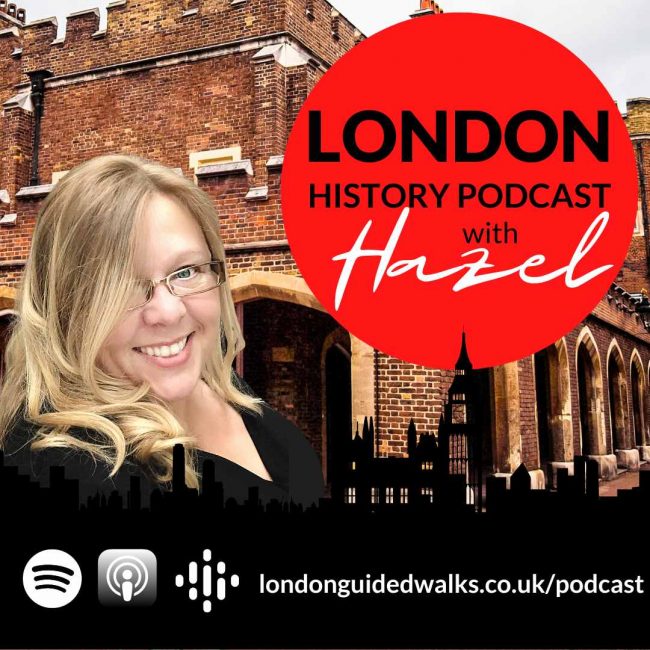

 Guest: Philip Scott
Guest: Philip Scott